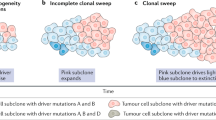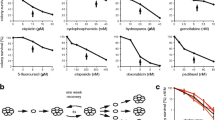Summary
To examine the relationship between altered spontaneous mutation rates and malignant characteristics of cells, two hydroxyurea-resistant Chinese hamster ovary cell lines, with alterations in ribonucleotide reductase, were examined for their rates of spontaneous mutation to 6-thioguanine and ouabain resistance, tumor growth rates and their ability to form experimental lung metastases. The most resistant cell line, HR-R2T, showed no changes in the rate of spontaneous mutation to 6-thioguanine or ouabain resistance compared to the parental wild-type cell line; however, the mutant line formed lung metastases in experimental metastasis assays with BALB/c nu/nu mice, and exhibited metastatic abilities significantly different from the wild-type population. Furthermore, the HR-R2T population did not show imbalances in any of the deoxyribonucleoside triphosphate pool sizes, which are frequently observed in cells altered in ribonucleotide reductase activity. The second hydroxyurea-resistant line, HNR-AT, had gross alterations in dCTP and dGTP pools and although the rate of spontaneous mutation to 6-thioguanione resistance was unaltered, it showed a moderate decrease in the rate of spontaneous mutation to ouabain resistance when compared to the parental wild-type population. Interestingly, the HNR-AT cell line did not form any lung metastases in the experimental metastasis assay. Both mutant cell lines, HR-R2T, and HNR-AT, had increased tumor growth rates in C57 BALB/c “beige” nude (nu/nu) mice as compared to the parental wildtype population. In total, the results obtained with the two mutant cell lines question the association of altered mutation rates with increased metastatic potential. Although several explanations are possible for the altered malignant properties exhibited by HR-R2T and HNR-AT cells, it is interesting to note that the results are consistent with earlier suggestions that changes in ribonucleotide reductase may accompany modifications in the malignant characteristics of cells.
Similar content being viewed by others
Abbreviations
- CHO:
-
Chinese hamster ovary
References
Akerblom L, Ehrenberg A, Graslund A, Lankinen H, Reichard P, Thelander L (1981) Overproduction of the free radical of ribonucleotide reductase in hydroxyurea-resistant mouse fibroblast 3T6 cells. Proc Natl Acad Sci (USA) 78:2159–2163
Albert DA, Gudas LJ, Nodzenski E (1987) Deoxyribonucleotide metabolism and cyclic AMP resistance in hydroxyurea-resistant S49 T-lymphoma cells. J Cell Physiol 130:262–269
Arpaia E, Ray PN, Siminovitch L (1983) Isolation of mutants of CHO cells resistant to 6(p-hydroxyphenylazo)-uracil. II. Mutants auxotrophic for deoxypyrimidines. Somatic Cell Genet 9:287–297
Cifone MA, Fidler IJ (1981) Increasing metastatic potential is associated with increasing genetic instability of clones isolated from murine neoplasms. Proc Natl Acad Sci (USA) 78:6949–6952
Creasey DC, Wright JA (1984) Involvement of ribonucleotide reductase in cellular differentiation. Biosci Rep 4:299–309
Dick JE, Wright JA (1984) Human diploid fibroblasts with alterations in ribonucleotide reductase activity, deoxyribonucleotide pools and in vitro lifespan. Mech Ageing Dev 26:37–49
Drobetsky E, Meuth M (1983) Increased mutational rates in Chinese hamster ovary cells serially selected for drug resistance. Mol Cell Biol 3:1882–1885
Egan SE, McClarty GA, Jarolim L, Wright JA, Spiro I, Hager G, Greenberg AH (1987) Expression of H-ras correlates with metastatic potential: evidence for direct regulation of the metastatic phenotype in 10T1/2 and NIH-3T3 cells. Mol Cell Biol 7:830–837
Elford HL (1972) Functional regulation of mammalian ribonucleotide reductase. Adv Enzyme Regul 10:19–28
Frost P, Kerbel RS, Hunt B, Man S, Pathak S (1987) Selection of metastatic variants with identifiable karyotypic changes from a nonmetastatic murine tumor after treatment with 2′-deoxy-5-azactidine or hydroxyurea: implications for the mechanisms of tumor progression. Cancer Res 47:2690–2695
Graslund A, Ehrenberg A, Thelander L (1982) Characterization of the free radical of mammalian ribonucleotide reductase. J Biol Chem 257:5711–5715
Greenberg AH, Egan SE, Jarolim L, Gingras MC, Wright JA (1987) Natural killer cell regulation of implantation and early lung growth of H-ras-transformed 10T1/2 fibroblasts in mice. Cancer Res 47:4801–4805
Hopper S (1972) Ribonucleotide reductase of rabbit bone marrow. I. purification, properties, and separation into two protein fractions. J Biol Chem 247:3336–3340
Hunting D, Henderson JF (1981) Determination of deoxyribonculeoside triphosphates using DNA polymerase: a critical evaluation. Can J Biochem 59:723–727
Kendal WS, Frost P (1986) Metastatic potential and spontaneous mutation rates: studies with two murine cell lines and their recently induced metastatic variants. Cancer Res 46:6131–6135
Khym JX (1975) An analytical system for rapid separation of tissue nucleotides at low pressures on conventional anion exchangers. Clin Chem 21:1245–1252
Lewis WH, Wright JA (1978) Genetic characterization of hydroxyurea resistance in Chinese hamster ovary cells. J Cell Physiol 97:73–86
Li I-C, Fu J, Hung Y-T, Chu EHY (1983) Estimation of mutation rates in cultured mammalian cells. Mutat Res 3:253–262
Liu PK, Chang C, Trosko JE (1982) Association of mutator activity with UV sensitivity in an aphidicolin-resistant mutant of Chinese hamster V79 cells. Mutat Res 106:317–332
Luria SE, Delbruck M (1943) Mutations of bacteria from virus sensitivity to virus resistance. Genetics 28:491–511
McClarty GA, Chan AK, Engstrom Y, Wright JA, Thelander L (1987) Elevated expression of M1 and M2 components and drug-induced post-transcriptional modulation of ribonucleotide reductase in a hydroxyurea-resistant mouse cell line. Biochemistry 26:8004–8011
Meuth M, L'Heureux-Huard N, Trudel M (1979) Characterization of a mutator gene in Chinese hamster ovary cells. Proc Natl Acad Sci (USA) 76:6505–6509
Nowell PC (1976) The clonal evolution of tumor cell populations. Science 194:23–28
Nowell PC (1986) Mechanisms of tumor progression. Cancer Res 46:2203–2207
Phear G, Nalbantoglu J, Meuth M (1987) Next-nucleotide effects in mutations driven by DNA precursor pool imbalances at the apart locus of Chinese hamster ovary cells. Proc Natl Acad Sci (USA) 84:4450–4454
Platt OS, Orkin SH, Dover O, Beardsley GP, Miller B, Nathan DG (1984) Hydroxyurea enhances fetal hemoglobin production in sickle cell anemia. J Clin Invest 74:652–656
Seshadri R, Kutlaca RJ, Trainor K, Matthews C, Morley AA (1987) Mutation rate of normal and malignant human lymphocytes. Cancer Res 47:407–409
Tagger AY, Wright JA (1984) A comparison of ribonucleotide reductase activities in normal human fibroblast strains with their transformed counterparts. Enzyme 32:142–148
Tagger AY, Wright JA (1988) Molecular and cellular characterization of drug resistant hamster cell lines with alterations in ribonucleotide reductase. Int J Cancer 42:760–766
Takeda E, Weber G (1981) Role of ribonucleotide reductase in the expression of the neoplastic program. Life Sci 28:1007–1014
Thelander L, Reichard P (1979) Reduction of ribonucleotides. Annu Rev Biochem 133:158
Weber G (1983) Biochemical strategy of cancer cells and the design of chemotherapy: G. H. A. Clowes memorial lecture. Cancer Res 43:3466–3492
Weinberg G, Ullman B, Martin DW Jr(1981) Mutator phenotypes in mammalian cell mutants with distinct biochemical defects and abnormal deoxyribonucleoside triphosphate pools. Proc Natl Acad Sci (USA) 78:2447–2451
Wright JA (1973) Evidence for pleiotropic changes in lines of Chinese hamster cells resistant to concanavalin A and phytohemagglutinin-P. J Cell Biol 56:666–675
Wright JA (1983) Altered forms of mammalian nucleoside diphosphate reductase from mutant cell lines. Pharmacol Ther 22:81–102
Wright JA (1989) Altered mammalian ribonucleoside diphosphate reductase from mutant cell lines. International Encyclopedia of Pharmacology and Therapeutics 128:89–111
Wright JA, McClarry GA, Lewis WH, Srinivasanl PR (1989) In: Gupta RS (eds) Drug resistance in mammalian cells. CRC Press, Boca Raton Florida (in press)
Yamashina K, Heppner GH (1985) Correlation of frequency of induced mutation and metastatic potential in tumor cell lines from a single mouse mammary tumor. Cancer Res 45:4015–4019
Author information
Authors and Affiliations
Rights and permissions
About this article
Cite this article
Tagger, A.Y., Damen, J.E., Greenberg, A.H. et al. Lack of correlation between deoxyribonucleotide pool sizes, spontaneous mutation rates and malignant potential in Chinese hamster ovary cells. J Cancer Res Clin Oncol 115, 429–434 (1989). https://doi.org/10.1007/BF00393331
Received:
Accepted:
Issue Date:
DOI: https://doi.org/10.1007/BF00393331




